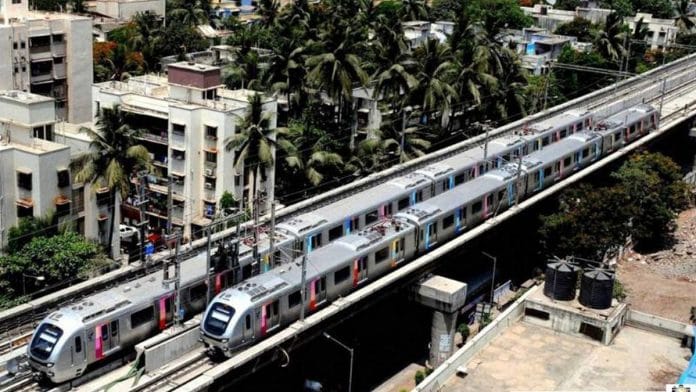State approves plans for two Metro lines — one links Andheri East to airport and the other connects satellite town of Mira Bhayander to Mumbai business district.
Mumbai: India’s commercial capital has taken one more step to expand its metro rail network and reduce the city’s dependence on the creaky, over-crowded local train system that is now its lifeline.
The Maharashtra government has approved plans for two new lines, one of which will bring a crowded satellite town, currently served by the cramped suburban railway line, on the metro map.
The second line will connect two under-construction corridors and thus offer contiguous metro connectivity right from the southern tip of Mumbai at Cuffe Parade to the northern tip at Dahisar.
“The two new lines will together cost Rs 6,607 crore,” said R.A. Rajeev, the metropolitan commissioner at the Mumbai Metropolitan Region Development Authority (MMRDA), the state’s nodal agency for the metro projects.
“We have tied up with the Japan International Cooperation Agency (JICA) for financing the projects. We expect the projects to be completed by 2022,” he added.
The approved extension will take the length of Mumbai’s metro network to 195 km. Delhi already has an operational metro network stretching more than 250 km, with plans to expand it by at least 100 km.
As of now, Mumbai has an 11.4-km operational metro line from Versova in the west to Ghatkopar in the east, with the construction of three more lines, measuring 68.6 km, underway.
Work on two more corridors, with a total length of 63.6 km, is scheduled to begin after the monsoon ends. Tendering for two projects spanning 38 km is also underway.
It was over 13 years ago that the Maharashtra government, then led by the Congress-NCP combine, first drew up a master plan to erect a 146-km metro network in Mumbai by 2021. However, the first line became operational only in 2014.
Regulatory hurdles and conflicts with the concessionaire delayed the first corridor, prevented the second corridor from taking off, and ultimately froze the entire master plan.
Also read: It took 6 years to build a metro line in Mumbai, but authorities say 3 will be ready by 2021
Mumbai’s metro dreams
For years, the Mumbai Metropolitan Region (MMR), comprising the city and its satellite settlements, has only been served by the decades-old suburban railway network that largely runs north to south. The stray lines connecting the east to the west are comparatively new.
The 427.5-km network carries nearly 80 lakh passengers every day, at least three times its capacity.
Add to this the fact that the condition of BEST-run public buses is poor. Besides, bad routes and tardy service have brought down the number of regular commuters to 29 lakh from 42 lakh in a decade.
The city’s 2,000-odd-km road network is insufficient to cater to a population of around 1.2 crore with about 30 lakh private vehicles.
Across the city and beyond
The lines cleared Tuesday include a 3.2-km corridor from Andheri East to the Chhatrapati Shivaji International Airport and a 10.41-km stretch from Dahisar East to Mira Bhayander.
The former will connect two under-construction metro lines — the 33.5-km Colaba-Bandra-Seepz underground corridor, which runs from South Mumbai to the western suburbs, and the Dahisar East-Andheri East elevated metro, which connects the western suburbs to the north-western fringe of Mumbai at Dahisar. Closer to the airport, the line will be partially underground.
The second line, a proposed elevated corridor from Dahisar, will offer connectivity to the satellite town of Mira Bhayander, in effect connecting the town directly to the airport as well as business districts such as SEEPZ, Bandra Kurla Complex and Nariman Point.
The Dahisar-Mira Bhayander Metro line will be completely elevated, while the Andheri East to airport.
The full plan
Mumbai eventually hopes to have a network spanning 275.3 km that covers the entire MMR. The government aims to have the tendering process for all the lines underway before 2019, when the Lok Sabha elections as well as the Maharashtra assembly polls are due.
“Besides the ones for which we have received cabinet approvals so far, there are three metro corridors for which the preparation of detailed project reports is under way,” said Rajeev of the MMRDA.
“We hope to secure the cabinet’s approval soon and start the tendering process by January,” he added.
The three projects in the pipeline include one from Wadala to GPO in south Mumbai, a line linking the Mumbai airport to the proposed Navi Mumbai International Airport, and a third connecting Mumbai’s satellite towns of Kalyan, Dombivli and Taloja. The cost to complete the entire 275.3-km network is pegged at Rs 88,000 crore. It is likely to be completed by 2026, officials said.
Also read: Mumbai wants to go as high as Tokyo & New York but where’s the infrastructure on the ground?






